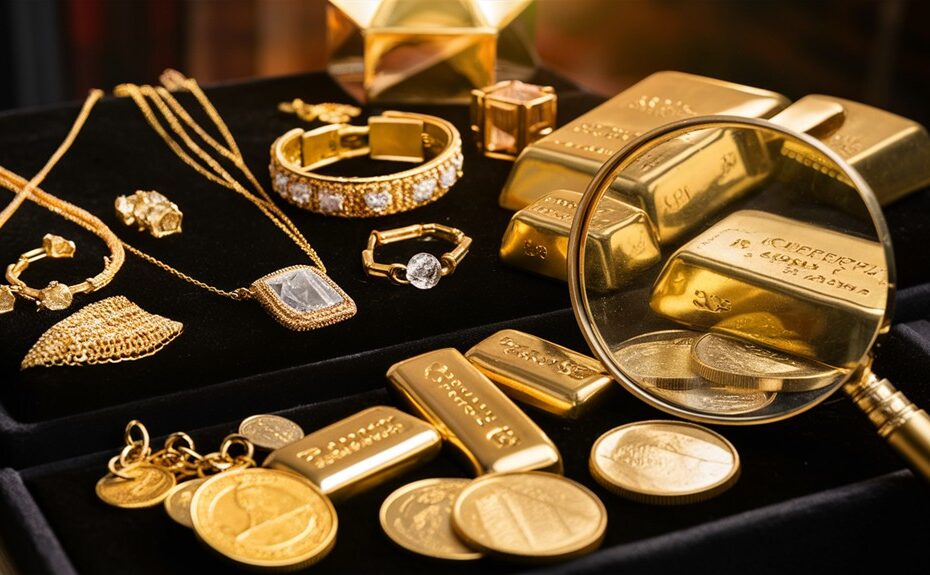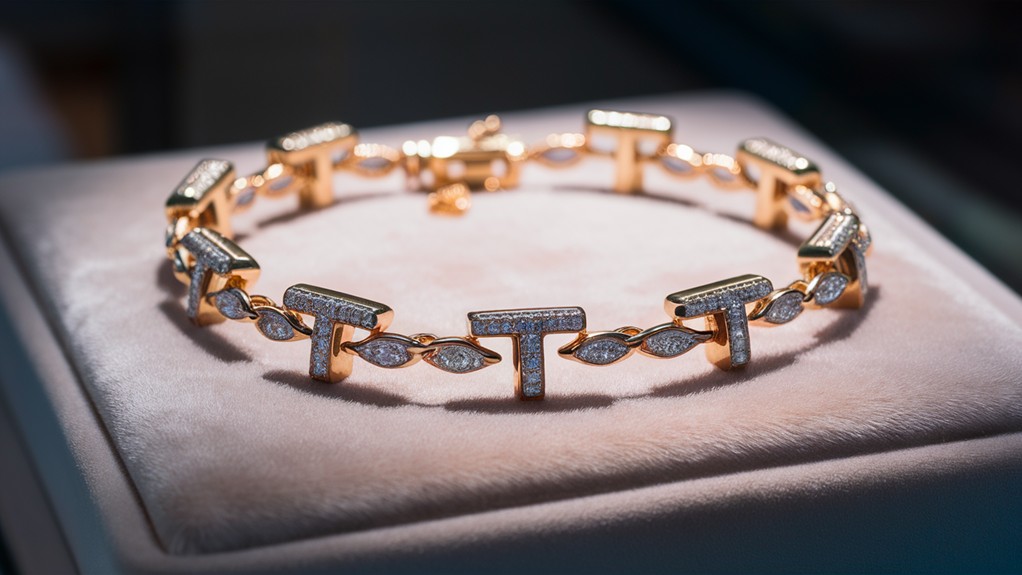As you consider investing in gold jewelry, you'll find that the market in 2024 offers a wealth of opportunities—and potential pitfalls. Understanding the subtleties of gold purity, from 14K to 22K, can make the difference between a wise investment and a costly mistake. You're not just buying a beautiful accessory; you're acquiring a tangible asset that could appreciate over time. But how do you balance the desire for durability with investment potential? And what market trends should you be aware of before making your purchase? The answers to these questions could greatly impact the value of your investment.
Our Highlighted Points
- 14K gold offers the best durability for daily wear while maintaining investment value.
- 18K gold balances higher purity with moderate durability, ideal for fine jewelry and investment.
- Authenticity stamps are crucial for ensuring investment-grade status and purity levels.
- Aim for 5-10% allocation of precious metals in your investment portfolio for optimal balance.
- Consider gold IRAs for tax advantages and long-term growth potential in precious metal investments.
Understanding Gold Purity Levels
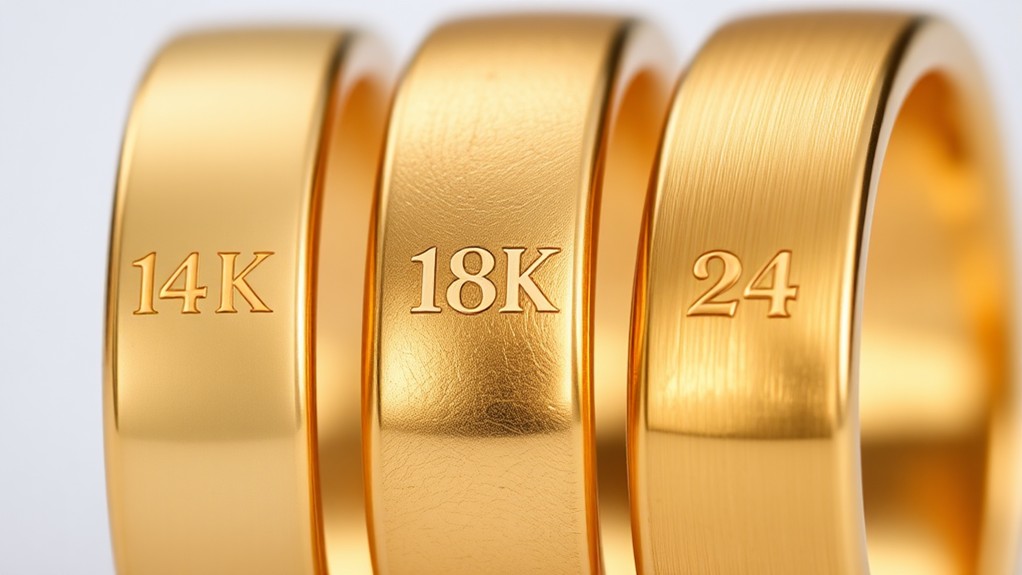
In the matter of choosing gold jewelry, understanding purity levels is vital. Gold purity is measured in karats (K), with 24K representing 100% pure gold. However, pure gold is soft and impractical for everyday wear, which is why jewelers often use alloys.
The most common gold purities for jewelry are:
- 14K gold (58% pure)
- 18K gold (75% pure)
14K gold is the most durable and ideal for everyday wear, making it a popular choice for engagement and wedding rings. It strikes a balance between purity and resilience, offering excellent value for jewelry investment.
When examining gold jewelry, look for a stamp of authenticity indicating its purity level. This stamp is critical for verifying the quality of your investment grade precious metals. Be cautious of pieces lacking this stamp, as they may not be genuine.
Understanding gold levels helps you make informed decisions based on your lifestyle needs and budget. For those seeking durability and affordability, 14K gold is an excellent choice.
If you prefer a higher gold content and are willing to invest more, 18K gold offers a richer color and greater purity.
Comparing 14K, 18K, and 22K
When choosing gold jewelry, you'll often encounter three common purity levels: 14K, 18K, and 22K. Each option offers distinct characteristics, balancing durability, cost, and appearance. To help you make an informed decision, let's compare these investment-grade precious metals:
| Feature | 14K Gold | 18K Gold | 22K Gold |
|---|---|---|---|
| Gold Content | 58% | 75% | 92% |
| Durability | Highest | Moderate | Lowest |
| Color | Lighter yellow | Rich yellow | Deep yellow |
| Ideal Use | Everyday wear | Fine jewelry | Special occasions |
In terms of durability, 14K gold reigns supreme, making it the best choice for engagement rings and daily-wear pieces. It's the most resistant to scratching and damage, ideal for those with active lifestyles. 18K gold strikes a balance between luxury and wearability, offering a richer color while maintaining reasonable durability. It's a popular choice for high-quality jewelry that sees regular use.
22K gold, with its deep yellow hue, is prized for its purity but requires careful handling. It's softer and more prone to damage, making it less suitable for everyday wear. However, its high gold content makes it an attractive option for special occasion pieces and as an investment.
Cost considerations align with gold purity; 22K and 18K command higher prices per gram than 14K because of their increased gold content.
Investment Potential of Gold Jewelry
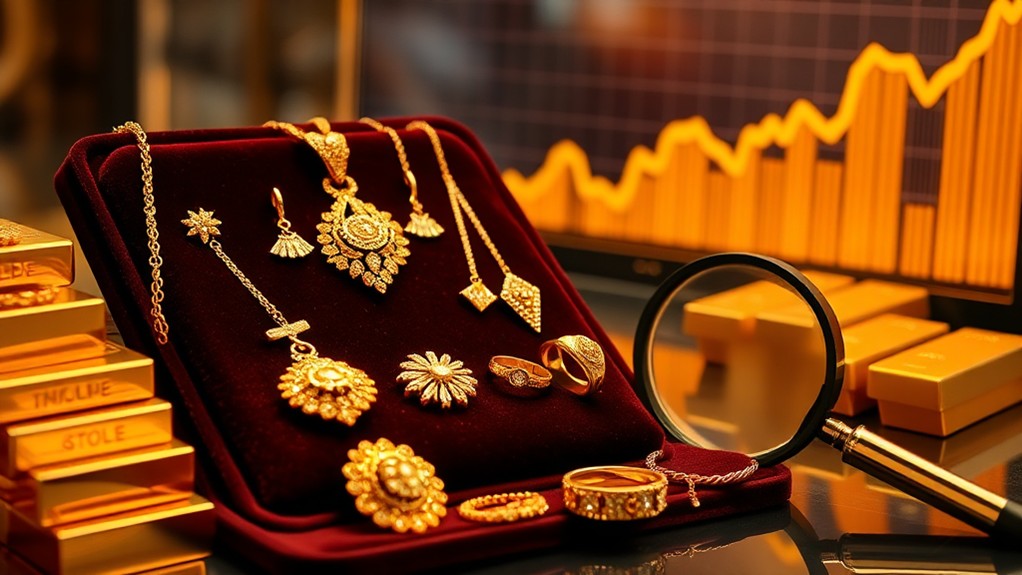
While many view gold jewelry primarily as adornment, it's essential to recognize its potential as an investment. Gold jewelry's inherent value lies in its gold content, which can serve as a hedge against economic downturns. When considering investment-grade pieces, focus on items with clear purity stamps indicating their karat value.
The investment potential of gold jewelry is closely tied to market prices for gold. As you build your collection, keep in mind that:
- 14K and 18K pieces offer a balance between durability and value retention.
- Higher karat jewelry (e.g., 22K) may have greater gold content but can be less practical for daily wear.
- Purity stamps provide assurance of a piece's investment-grade status.
Gold jewelry's dual nature as both aesthetic enjoyment and financial asset makes it an attractive option for broadening your investment portfolio. During economic uncertainty, gold typically maintains its value, potentially outperforming other assets.
When purchasing gold jewelry for investment purposes, prioritize:
- Reputable dealers
- Certified pieces
- Well-documented provenance
Durability and Wear Considerations
Beyond investment potential, the durability of gold jewelry plays a key role in its long-term value and wearability. Furthermore, durable gold rings can withstand daily wear and tear, making them a timeless and reliable choice for everyday jewelry. This durability gives gold pieces the ability to last for generations, maintaining their beauty and value over time. As a result, gold jewelry is not only a fashion statement but also a long-term investment that can be passed down through family members.
When selecting gold jewelry, consider the following durability factors based on gold karat:
- 14K Gold: The most durable option for everyday wear, containing 58% gold. Resistant to scratching and deformation, making it ideal for active lifestyles.
- 18K Gold: Offers a balance of durability and rich color with 75% gold content. Softer than 14K, requiring more care but still suitable for regular use.
- 22K Gold: With 92% gold purity, it's stronger than 24K but remains relatively soft. Best suited for special occasion jewelry rather than daily wear.
- 24K Gold: Pure gold (100%) is the softest and most malleable, making it impractical for frequently worn jewelry because of its susceptibility to damage.
Your lifestyle and activity levels should guide your choice of gold karat.
Higher purity levels may require more careful handling, while lower karats offer increased durability.
For those with active lifestyles or who plan to wear their jewelry daily, 14K or 18K gold provides the best balance of durability and aesthetic appeal.
Market Trends in Gold Jewelry
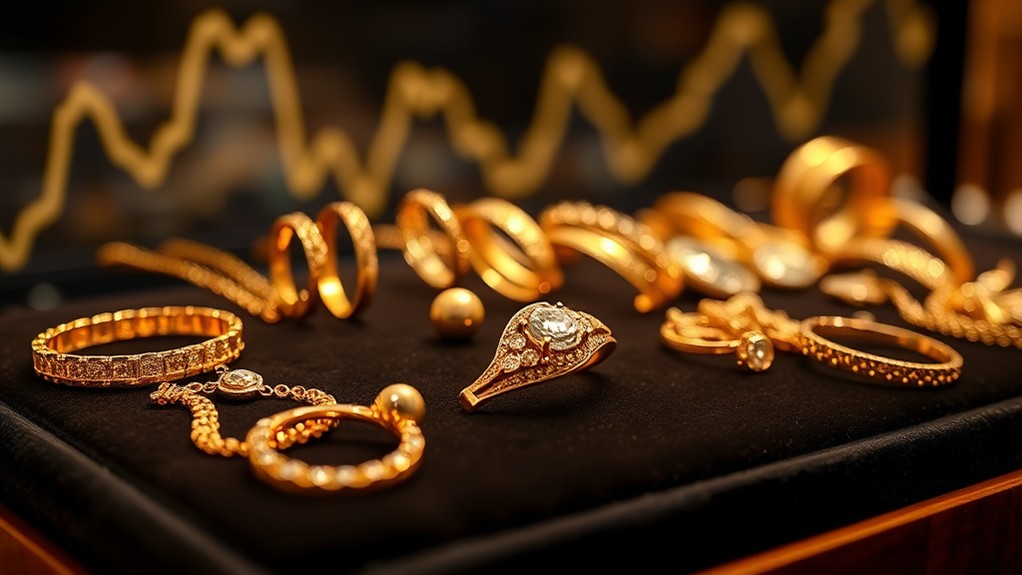
Reflecting the ever-changing dynamics of consumer preferences and economic conditions, the gold jewelry market continues to evolve. As we approach 2024, several key trends are shaping the landscape of investment-grade precious metals in jewelry:
- Demand for high-quality pieces: 18K and 14K gold are leading choices for durability and aesthetic appeal.
- Economic factors: Inflation and geopolitical tensions drive consumers toward gold jewelry as a safe-haven investment.
- Market growth: The global gold jewelry market, valued at $250 billion in 2023, is projected to expand further.
- Ethical sourcing: Consumers increasingly favor brands promoting sustainable and responsibly mined gold.
- Digital platforms: Online retailers offer competitive pricing and wider selection compared to traditional stores.
| Trend | Driver | Impact |
|---|---|---|
| Quality focus | Consumer preferences | Increased demand for 18K and 14K gold |
| Economic uncertainty | Geopolitical tensions | Gold jewelry as investment vehicle |
| Ethical concerns | Sustainability awareness | Preference for responsibly sourced gold |
| E-commerce growth | Digital adoption | Shift towards online jewelry purchases |
To capitalize on these market trends, consider investing in high-quality gold pieces from reputable sources. Prioritize ethical sourcing and investigate online retailers for competitive pricing and diverse options. Remember, gold jewelry's value extends beyond aesthetics, serving as a potential hedge against economic uncertainties in 2024 and beyond.
Buying and Selling Gold Pieces
As you venture into the world of gold jewelry, understanding the intricacies of buying and selling these precious pieces is fundamental.
When purchasing investment-grade gold jewelry, consider the following factors:
- Purity stamps: Confirm pieces are at least 14K for better value retention
- Karat options: 14K offers durability, while 18K and 22K provide higher gold content
- Pricing structure: Retail price includes spot price plus markup for craftsmanship
- Storage solutions: Home safes or secure depositories, with insurance coverage for valuable items
When buying gold jewelry, be aware that the retail price incorporates the current spot price of gold and a markup for design and craftsmanship. This knowledge will help you make informed decisions about the value of your purchase.
Conversely, when selling gold pieces, expect lower buyback prices because of the spread between buying and selling rates. Quick-sale options like "we buy gold" businesses may offer even less favorable terms.
For those considering gold jewelry as an investment, proper storage is significant. Options range from home safes for smaller collections to secure depositories for larger holdings.
Regardless of storage method, obtaining adequate insurance coverage is critical to protect your precious metal investments.
Precious Metal Investment Strategies
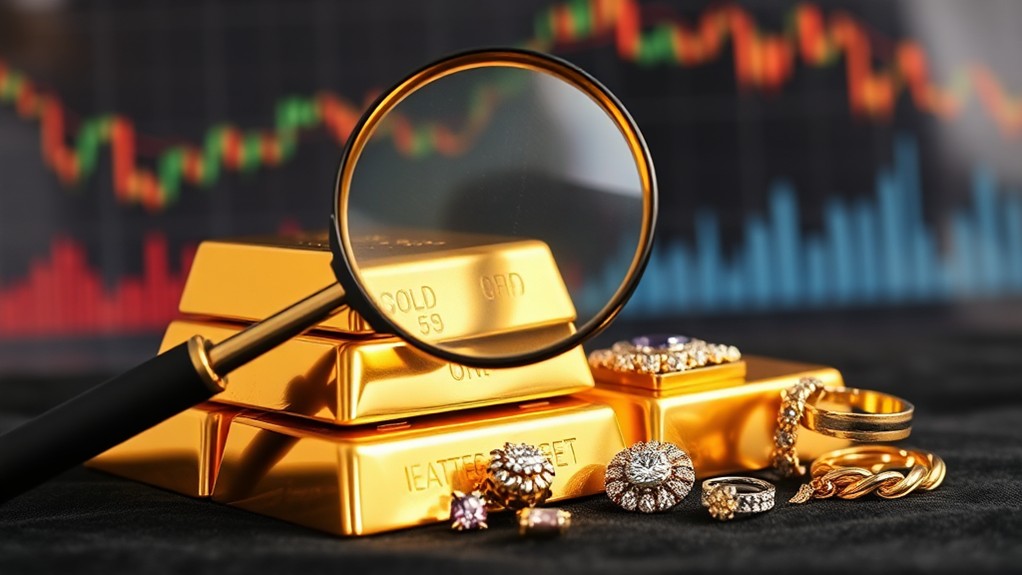
While gold jewelry offers aesthetic appeal, investing in precious metals requires a strategic approach. To enhance your precious metal investments, consider these key strategies:
- Balanced Portfolio Allocation:
- Aim for 5-10% of your investment portfolio in precious metals
- Combine physical gold and ETFs to reduce risk and increase returns
- Diversification:
- Purchase gold bullion coins, bars, and rounds
- Invest in mining stocks for exposure to market pressures
- Utilize Gold IRAs:
- Incorporate precious metals into self-directed IRAs
- Benefit from long-term growth and tax advantages
- Stay Informed:
- Monitor geopolitical factors and market trends
- Make informed investment decisions based on current events
To implement these strategies effectively:
- Research reputable dealers for physical gold purchases
- Consult with financial advisors to tailor your portfolio
- Regularly review and rebalance your investments
- Consider storage options for physical gold (e.g., secure vaults)
- Understand the tax implications of precious metal investments
Frequently Asked Questions
What Is the Best Precious Metal to Invest in In 2024?
Gold is your best bet for precious metal investment in 2024. It's expected to maintain stability during economic fluctuations and outperform other metals. You'll find diverse investment options, including physical bullion, ETFs, and mutual funds.
What Is the Best Form of Gold to Buy for Investment?
For investment, you'll want to buy 0.999 fine gold bullion. You can choose between coins like Canadian Gold Maple Leafs or American Buffalos, or gold bars. They're highly liquid and retain value well. Gold ETFs are likewise a solid option.
What Is the Best Gold Jewelry to Invest In?
You'll find 18K gold jewelry is your best investment option. It offers a balance of durability and high gold content. Look for pieces with clear purity stamps and consider popular designs that'll maintain their value over time.
What Is the Best Physical Gold to Buy for Investment?
For investment, you'll want to buy 0.999 fine gold bullion coins or bars. Popular choices include Canada Gold Maple Leafs and South African Krugerrands. Choose products from reputable mints and verify their authenticity before purchasing. Always consider the spot price and premiums.
